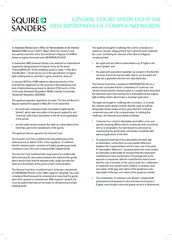

In September 2009 Universal Display Corp obtained an international registration designating the European Union for the word UniversalPHOLED for the following goods in Class 1 of the Nice Classi57375cation chemicals for use in the manufacture of orga ID: 76348
Download Pdf The PPT/PDF document "In Universal Display Corp v Ofce for Har..." is the property of its rightful owner. Permission is granted to download and print the materials on this web site for personal, non-commercial use only, and to display it on your personal computer provided you do not modify the materials and that you retain all copyright notices contained in the materials. By downloading content from our website, you accept the terms of this agreement.
Universal Display Corp v Of ce for Harmonisation in the Internal (OHIM) (Case T-435/11, May 2 2012), the General Court has upheld a decision of the Second Board of Appeal of OHIM to In September 2009 Universal Display Corp obtained an international registration designating the European Union for the word ‘UniversalPHOLED’ for the following goods in Class 1 of the Nice Classi cation: “chemicals for use in the manufacture of organic In January 2010 the OHIM examiner refused protection of the international registration on the grounds of descriptiveness and lack of distinctiveness pursuant to Articles 7(1)(b) and (c) of the Community Trademark Regulation (40/94) (now the Community Trademark Regulation (207/2009)).The applicant appealed against the decision. The Second Board of the mark was composed of two descriptive English words: ‘pholed’, which was descriptive of the goods applied for, and ‘universal’, which was descriptive of the all-round application of the goods; and the public would consider the mark as a description of the The General Court rst considered the descriptiveness of the GENERAL COURT SHEDS LI The contents of this update are not intended to serve as legal advice related to individual situations or as legal opinions concerning such situations nor should they be considered a substitute for taking legal advice.© Squire Sanders.All Rights Reserved 2012squiresanders.com The applicant also submitted that UNIVERSALPHOLED was not descriptive of the goods because lightemitting diodes are not chemical substances and are therefore covered by Class 9, not Class 1. The General Court rejected this submission for two Chemical substances (eg, phosphorus) are used in the manufacture of light-emitting diodes, even though the diodes Notwithstanding the above, the application speci cally The applicant further submitted that, due to its leading reputation in the eld, the relevant public would establish a link between ‘universal’ and ‘pholed’ and believe that the goods bearing the mark were manufactured by the applicant. The General Court rejected this submission on the basis that the applicant had not The applicant also sought to rely on an existing portfolio of trademarks containing the word ‘universal’ and on the principle of decisions to register a Community trademark must be based on the regulation, not the previous practice of the Boards of the principle of equal treatment must be applied in a manner that is consistent with the principle of legality (ie, a person may Therefore, the applicant could not rely on OHIM’s previous of legality.The General Court did not consider the distinctiveness of the mark in any detail given that the mark was not registrable due to There is a body of case law showing that tribunals often commit an error of law in their assessment of a compound word. Whilst it is usual for a tribunal to examine the component elements of a compound word as a step in its analysis, it is the assessment of the whole word which truly matters, as the General Court reiterated in the case in point. The underlying principle behind this approach is that the average consumer normally perceives a word as a whole and does not analyse its constituent parts. Not surprisingly, theGeneral Court has reaf rmed that the obligation to assess a compound word as a whole applies when Article 7(1)(c) of the regulation is being considered. T +44 207 655 1144 E ellie.forrest-charde@squiresanders.com This article rst appeared on WTR Daily, part of World Trademark Review, in May 2012. For further information, please go to www.worldtrademarkreview.com